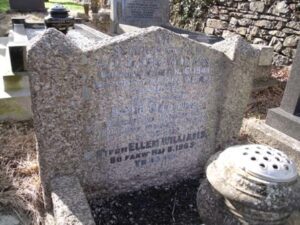The airmen of the Borough of Carmarthen who fell in both World Wars are commemorated on a wooden memorial, which is located inside the Carmarthen branch of the Royal Air Force Association Gremlin Club, which is situated in the Guildhall Square. There are several notable personalities commemorated on the memorial. The dedication on the Memorial reads; ‘To those Men and Women of the Borough of Carmarthen Who Fell in the Two World Wars’. There is another memorial with similar names inside St. Peter’s Church.
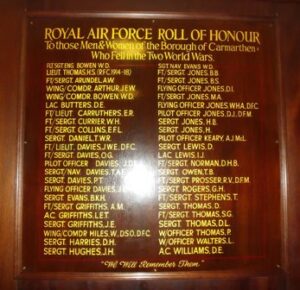
The Great War, 1914-1918
Parcell Rees Bowen, MC, DFC and Bar, Captain, Welsh Regiment. Parcell was the fourth son of Josiah and Mary Bowen, of Pantyglien, Abergwili. Parcell was a student at St. David’s College, Lampeter when he enlisted at the outbreak of War, becoming a Private in the Army Service Corps. He spent the winter of 1914/15 in France, but in February, 1915 was sent home with badly frostbitten feet. In July that year, he was commissioned as a Second Lieutenant into the 5th Welsh, and he embarked with the Battalion for Gallipoli, where the Battalion formed part of 159 Brigade, 53rd (Welsh) Division. The Division fought at Gallipoli until the evacuation in December, suffering badly from casualties, forcing the 5th Welsh to merge with the 4th Welsh for a short period. After the evacuation, Parcell fought in the Palestinian Campaign, where he then transferred into the Machine Gun Corps, and it was with them that he was awarded his first decoration, the Military Cross. Parcell then transferred into the Royal Air Force on 10 January 1918, becoming an Observer. He gained his second decoration during the air war in Egypt, the Distinguished Service Order. After the Armistice on 11 November 1918, Parcell served in Salonika and Mesopotamia, before being placed on the unemployed list. Again though, Parcell wanted more adventure, and so he volunteered for further service with the R.A.F. in their private war in North Russia, fighting for the White Russians. On 17 July 1919 Parcell arrived at Archangel, where he met his old compatriot from Carmarthen, Ira ‘Taffy’ Jones.
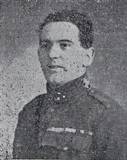
In Ira Jones’s book, ‘An Airfighter’s Scrapbook’, Ira writes glowing reports of Parcell, being glad to see another Welsh Warrior in his Squadron. A long passage from the book tells of an incident that earned Parcell a Bar to his Distinguished Flying Cross. In short, Parcell and his Pilot were carrying out a bombing mission when they came across a superior force of Russian Aeroplanes. Being the men they were, they agreed to attack the Russians, who dispersed in chaos when these two madmen plunged into their midst. The Russians took flight, but one fired a burst of rounds at the British pair, and Parcell and his Pilot were hit. The Pilot fainted at the controls of the aeroplane, and Parcell only had one good arm, but he leaned over his colleague and piloted the aeroplane back nearly 100 miles to base. Parcell was sent home wounded, and again placed on the Unemployed List, so volunteered for a Commission into the Lithuanian Army, with whom he served until July 1920 when he accepted a Government Post. This post was Top Secret, and involved him going undercover in Dublin, at the time when the troubles were at a peak. Due to the secrecy of the work being carried out in Ireland, nothing much is known about the operations Parcell was engaged in. What is known is that Parcell had been lodging with a fellow Officer at 28, Upper Fitzwilliam Street, Dublin, and the two had spent the afternoon of 27 October 1920 watching a football match at Donnybrook. After the match, Parcell could not be found, until his lifeless body was discovered, lying face down, at Merrion Street. He had been shot in the back by an IRA assassin, the bullet hitting his spine. Parcell’s body was brought back to Carmarthen, where he was buried with full military honours in Abergwili Churchyard. Within a month, on ‘Bloody Sunday’, 21 November 1920, fourteen British Agents were murdered in Dublin by the I.R.A., led by Michael Collins. The British Army reprised the killings by storming into a Gaelic Football match at Croke Park in Dublin, and fired into the crowd to avenge their murdered colleagues, inflicting many casualties, with fourteen men and children dead. Later that night, three IRA prisoners suspiciously died in captivity in Dublin Castle, and the situation swiftly escalated. The Irish Public quickly turned against the Crown, and Peace negotiations ensued, resulting in a truce being declared on 11 July 1921.
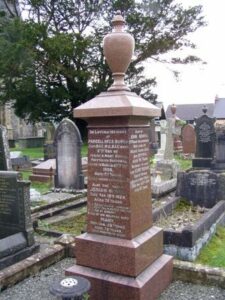
Francis Bernard Evans, Second Lieutenant, Royal Flying Corps & Artists Rifles. Francis was born at London on 19 September 1895, the son of Alfred and Florence Evans, of 27, North Side, Clapham Common, London. He had served in France with the Artists Rifles between 1915 until 1917, before being commissioned into the Royal Flying Corps, and was posted to 110 Squadron, based at Sedgeford. On 17 February 1918, Francis was flying a DH4, Serial B9994, when the aircraft caught fire in the air and crashed, killing him. He was 22 years old, and is buried with his wife Florence Nelson at Hunstanton (St. Mary) Churchyard, England. Francis is not commemorated on the Gremlin Club Memorial, but is listed on the Carmarthen County War Memorial as being a Carmarthen man.
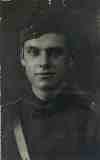
Stanley Short, Air Mechanic, 406173, Royal Air Force. Stanley was the son of Mr. and Mrs. Morgan Short of Abertillery. He married Esther Ann Lane at Carmarthen in 1912, and the couple lived at 20, Orchard Street, Carmarthen. Stanley served during the war with the 119th Squadron, Royal Air Force. He died of pneumonia at Feltham, near Staines, on 3 November 1918, aged 25, and was brought home for burial at Carmarthen Cemetery. Stanley is not named on the County War Memorial roll.
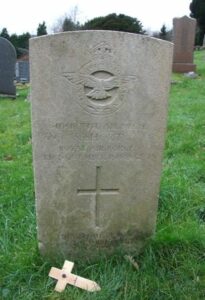
Hugh Spencer Thomas, Second Lieutenant, Royal Air Force. Hugh was the son of John Henry and Elizabeth Anne Thomas, of 7, Spilman Street, Carmarthen. He gained a commission into the Royal Flying Corps in November 1917, where he trained as a pilot. After his training, Hugh was posted to 27 Squadron, Royal Air Force, which was based in France flying the DH4. On 29 September 1918, Hugh was piloting DHP, Serial D3172 on a bombing run over Busigny, when his aircraft came under attack from a German fighter from Jasta 5, piloted by Unterofficer K. Treiber. At 08.45, Hugh’s aircraft was shot down and crashed, killing Hugh, and his Observer, Thomas Brown. Hugh was 19 years old, and is buried at Esquelbecq Military Cemetery, France. His Observer, Second Lieutenant Thomas Brown, is buried at Escaufourt Communal Cemetery, France.
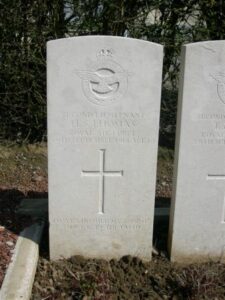
Richard Henry Watson, Leading Mechanic, F/3307, Royal Naval Air Service. Richard was born in Hong Kong on 10 September 1895, the son of H. J. Watson and Emmeline Watson. After his father’s death, Emmeline moved the family back to 47, Lammas Street, Carmarthen. Richard and his brother Arthur attended Carmarthen Grammar School prior to the war, and were both members of Carmarthen Harlequins Rugby Club. At the beginning of the war they both enlisted, and Richard joined the Royal Naval Air Service as a Mechanic. Richard was posted to the Dunkerque Air Station, and in April 1917 a report appeared in the Carmarthen Journal that both brothers had been reported missing during that month. Arthur turned up as a Prisoner of War in Germany after having been shot down whilst serving with the Royal Flying Corps, but Richard was discovered to have been shot down whilst flying a HP 0/100 off Nieuport, and taken prisoner. He died of wounds on 26 April 1917, aged just 22, and is commemorated on the Chatham Naval Memorial, Kent.
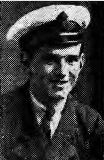
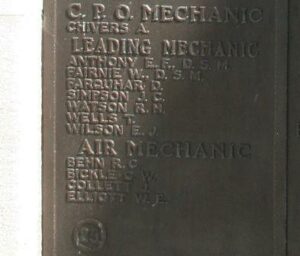
Arthur Charles Williams, Air Mechanic 3rd Class, 111633, Royal Air Force. Arthur was the son of the late Henry and Margaret Williams, of St. Peters, Carmarthen, and the Husband of Minnie L. Williams, of 78, St. Stephen’s Avenue, Shepherd’s Bush, London. Arthur died on active service on 12 December 1918. He was 49 years old, and is buried at Hendon Cemetery, England. Arthur is not commemorated on the Gremlin Club Memorial.
———————————————————————————————————————————————————————————
World War Two, 1939-1945
John Edward Wilberforce Arthur, Wing Commander, 87084, Royal Air Force Volunteer Reserve. John was born in 1906, the son of Arthur Arthur and Hannah Jane Arthur (nee Davies), of Penrhos, Carway View, Carmarthen. He enlisted into the Royal Air Force Volunteer Reserve and was commissioned from Leading Aircraftman to Flight Lieutenant on 3 July 1940, joining the Balloon Branch. John was later promoted to Wing Commander and became attached to the HQ of the NWAAF, in Tunis. John died as a result of a vehicle accident in North Africa on 29 September 1943. The 37-year-old was originally buried in La Borgel Civil Cemetery in Tunis, but in August 1944 the military graves within the cemetery were relocated into Medjez-El-Bab War Cemetery, Tunisia.
Archie Winston Arundel, Flight Sergeant, 964173, Royal Air Force Volunteer Reserve. Archie was born on 11 November 1913, the son of Phillip John Arundel and Ellen Arundel (nee Evans), of Pentrefelin, Carmarthen. He married Violet Marcel Northam in 1938 and the couple set up home at 18, Bridge Street, Carmarthen. Archie enlisted into the Royal Air Force Volunteer Reserve soon after the outbreak of war and was posted to 2742 Squadron, Royal Air Force, which was an Armoured Cars unit. The unit landed at Gold Beach on D-Day plus 22, 28 June 1944, for airfield defence duties. Archie died in France on 5 March 1945. The 31-year-old was originally buried in Andilly American Cemetery, but in February 1947 the British war graves within the cemetery were exhumed and relocated into Choloy War Cemetery, France. His brother Ivor also fell.
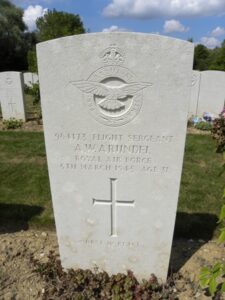
William Donald Bowen, Sergeant (Flight Engineer), 1378175, Royal Air Force Volunteer Reserve. William was born in 1916, the son of Thomas Benjamin Bowen and Mary Bowen (nee Morgan), of Carmarthen. He married Beryl Williams, of 5, Mansel Street, Carmarthen, in 1941. William enlisted into the Royal Air Force Volunteer Reserve and after completing his training as a Flight Engineer was posted to 15 Squadron, Royal Air Force, which was a heavy bomber squadron, armed with the Short Stirling III, based at RAF Bourn. On the night of 1 March 1943, William took off from Bourn as part of the crew of Stirling W7518. At around 01.00 the following morning, the Halifax was intercepted by a German FW night fighter, and was shot down above the Oosterschelde. Of the crew of seven, only one man escaped. William and five of his crewmates died in the crash on the morning of 2 March 1943, and are buried together at Bergen-Op-Zoom War Cemetery, Netherlands. William was 27 years old.
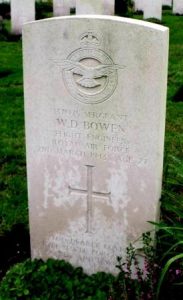
Daniel Eric Butters, Leading Aircraftman, Royal Air Force. Daniel was born in 1920, the son of Alfred John Butters and Mary Jane Butters (nee Williams), of 12, St. John Street, Carmarthen. He enlisted into the Royal Air Force, and was sent to Canada under the Empire Air Training Scheme, for further training. Daniel met, and married, Marion Jean Campbell, of Detroit, at Wayne, Michigan, and they had a son, Michael, born in 1943. Daniel contracted cancer, and was repatriated home, but sadly died in Carmarthen in 1944, aged 24. Daniel is not commemorated by the CWGC, so nothing further is known of him.
Edgar Roy Carruthers, Flight Lieutenant (Pilot), 155753, Royal Air Force Volunteer Reserve. Edgar was born on 15 March 1921, the son of Christopher Carruthers and Hannah Jane Carruthers (nee Hughes), of 21, Bridge Street, Carmarthen. He worked as a Civil Servant in Cardiff prior to enlisting into the Royal Air Force Volunteer Reserve and trained as a pilot before being gazetted as Flight Sergeant in November 1943. He was then posted to 609 Squadron, Royal Air Force, which was an RAF Fighter Command unit, equipped with the Supermarine Spitfire, based at RAF Duxford. In the summer of 1942 the squadron re-equipped with Hawker Typhoon IB’s, to counter the Luftwaffe’s Focke-Wulf Fw 190 fighter, and was very successful. During the opening months of 1944 the Squadron was involved with the destruction of German Radar Stations along the French Coast, prior to the Normandy Landings, then took part in air strikes on vital targets in occupied Europe. After the end of the war, the Squadron remained in Germany, based at RAF Wunstorf. Edgar was killed when he flew his Hawker Typhoon IB into the ground whilst descending through low cloud on 8 August 1945. The 24-year-old was buried in Becklingen War Cemetery, Germany.
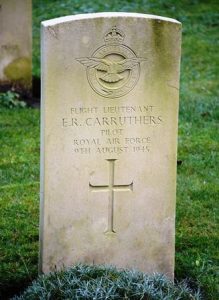
Ernest Francis Lewis Collins, Flight Sergeant, 967795, Royal Air Force Volunteer Reserve. Ernest was born in Swansea in 1918, the son of Ernest Frederick Coates Collins and Frances Jane Collins (nee Lewis). The family moved to his mothers native Carmarthen soon after Ernest’s birth. Ernest enlisted into the Royal Air Force Volunteer Reserve and after completing his training was posted to 106 Squadron, Royal Air Force, a Bomber Command unit, based at RAF Metheringham, Lincolnshire. On the night of 29/30 August 1944 Ernest took off from Metheringham aboard an Avro Lancaster III, Serial JB593 ZN-T. The Lancaster was intercepted and shot down in the Konigsberg area of Germany during the early hours of 30 August 1944, killing all the crew. Ernest was 26 years old when he was killed that morning and is commemorated alongside his fellow crewmen on the Runnymede Memorial, Surrey. A memorial has recently been unveiled at Metheringham to commemorate the crew of Lancaster JB593 ZN-T: Group Captain William McKechnie, Sergeant Robert Barclay Clarke, Flight Sergeant Henry William Tilson Carter, Sergeant Charles Colin Jeffrey, Sergeant Douglas Forster and Flight Sergeant Ernest Lewis Collins. (Many thanks to Marita Aitken for initially identifying Ernest).

Wilfred Herbert Currier, Sergeant (Wireless Operator/Air Gunner), 1316120, Royal Air Force Volunteer Reserve. Wilfred was born on 15 June 1921, the son of Herbert George Currier and Alice Currier (nee Stafford), of 20, Bridge Street, Carmarthen. He worked as a Printer’s Apprentice prior to the war, then enlisted into the Royal Air Force Volunteer Reserve, and after completing his training as a Wireless Operator/ Air Gunner was posted to 115 Squadron, Royal Air Force, a heavy bomber squadron, equipped with the Avro Lancaster II, based at RAF Little Snoring. On the night of 18 October 1943, Wilfred took off from Little Snoring aboard an Avro Lancaster II, Serial DS769, which joined a force of some 360 aircraft despatched to strike targets in Hanover. The aircraft of the Pathfinder Force were unable to mark the targets due to cloud cover, and the raid, the last on Hanover, was a failure. Wilfred was killed when his Lancaster was shot down over Germany during the raid, on 18 October 1943. The remains of the 22-year-old, together with three fellow crewmen, were recovered from the wreckage of the Lancaster and buried in Altenberge Communal Cemetery as unknown airmen. In May 1947 the graves were exhumed and identified, before being re-interred in Reichswald Forest War Cemetery, Germany.
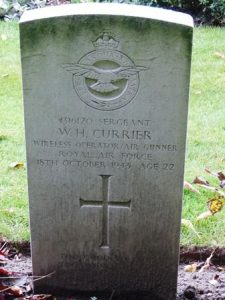
Thomas William Reynold Daniel, Sergeant, 1315951, Royal Air Force Volunteer Reserve. Thomas was born in 1921, the son of William Henry Daniel and Margaret Emily Daniel (nee Davies), of Carmarthen. He enlisted into the Royal Air Force Volunteer Reserve and after completing his training as an Air Gunner was posted to 78 Squadron, Royal Air Force, a Heavy Bomber unit, which was equipped with the Handley Page Halifax, based at RAF Breighton. On the night of 11 June 1943, Thomas took off from Breighton aboard a Handley Page Halifax II, Serial W7932, which joined a force of some 783 aircraft despatched to strike targets in Düsseldorf. Severe damage was caused to the centre of Düsseldorf with at least 130 acres laid waste and almost 1,300 people killed, whilst eight ships were damaged. Thomas was killed on the return journey, when his Halifax was intercepted by a German night fighter and shot down and crashed some two miles west of Sambeek, Holland, on the morning of 12 June 1943. Thomas was 21 years old when he was killed that morning and was buried alongside his six fellow crewmen in Eindhoven (Woensel) General Cemetery, Netherlands.
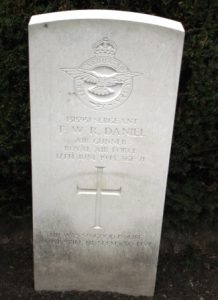
James Glyn Davies, Flying Officer, 175652, Royal Air Force Volunteer Reserve. James was born in 1913, the son of Thomas Davies and Mary Davies (nee Lewis), of Carmarthen. He married Hannah May Daniel, of Bronwydd, in 1941. James enlisted into the Royal Air Force Volunteer Reserve and after completing his training as a pilot was posted to 166 Squadron, Royal Air Force, which was a heavy bomber unit, equipped with the Avro Lancaster III, based at RAF Kirmington. On the night of 23 September 1944, James took off from Kirmington, flying an Avro Lancaster III, Serial LM722, which joined a bomber group despatched to strike targets in Neuss. James was killed when his Lancaster was lost without trace on the following morning, 24 September 1944, with its entire crew of seven men. The 31-year-old is commemorated on the Runnymede Memorial, Surrey.

James William Elias Davies, DFC, Flight Sergeant, 37796, Royal Air Force. James, known as Jimmy, was born in America in 1914, the son of David Ashley Davies and Catherine Isabella Davies (nee Elias). His parents were both Welsh, and after the end of the Great War, settling at Towy Villa, Cwmoernant, Carmarthen. James joined the Royal Air Force in 1936, and by the outbreak of war was a fighter pilot with 79 Squadron, which was equipped with the Hawker Hurricane I, based at RAF Biggin Hill in Kent. The squadron was soon in action and by the end of June 1940 Davies had already claimed six German aircraft, with two shared claims. On 27 June 1940 he was due to be presented with the Distinguished Flying Cross from the King when he was sent as an escort to protect six aircraft on a reconnaissance mission to the French port of St Valery. Jimmy was piloting one of three Hurricanes on the flight, when they were attacked by three Messerschmitt Bf109s over the English Channel. One of the Hurricanes escaped, but Jimmy and one other were shot down into the sea, the other one pilot bailing out safely. Jimmy became the first American born pilot to be shot down and killed in World War Two. He was 26 years old. His Distinguished Flying Cross, which he didn’t see himself, was awarded for ‘This officer has shown ability as a leader of his squadron on many offensive patrols. On one occasion while attacking a Messerschmitt 109, he was himself attacked by six Heinkel 113’s. He at once turned on the Heinkels destroying one and badly damaging a second before being compelled to break off the engagement owing to shortage of ammunition. The following day he sighted and attacked a large formation of Heinkel 111’s and shot one down in flames.’ He had also been Mentioned in Despatches for his gallant conduct.
John Derrick Edwards Davies, Pilot Officer (Air Gunner), 176215, Royal Air Force Volunteer Reserve. John was born on 23 December 1922, the son of Daniel Edwards Davies and Katherine Davies (nee Jones), of Carmarthen, and was baptised at St. David’s Church. His father worked as a Bank Clerk for the National Provincial Bank, and by 1939 the family had moved to Whitchurch, Shropshire. John was a student when war broke out, and left his studies to enlist into the Royal Air Force Volunteer Reserve. After training as an Air Gunner he was posted to 180 Squadron, Royal Air Force, which was equipped with the North American Mitchell II, based at RAF Dunsfold. On 15 June 1944 John was taking part in a raid on a Panzer HQ in France, supporting the Normandy landings, when the aircraft was hit by Flak and he was killed. The damaged aircraft landed safely and the rest of the crew survived. The 21-year-old was buried in Brookwood Military Cemetery, Surrey.
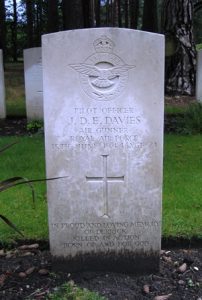
Oliver Geoffrey Davies, Flight Sergeant, 972287, Royal Air Force Volunteer Reserve. Oliver was born on 18 April 1920, the son of John Joseph Davies and Kate Marion Davies (nee Hughes), of 8, Lime Grove Avenue, Carmarthen. He worked as an Insurance Agent prior to enlisting into the Royal Air Force Volunteer Reserve, and after completing his training as a Wireless Operator/ Air Gunner was posted to 612 Squadron, Royal Air Force, which was equipped with the Vickers Wellington VIII, and the Armstrong Whitworth Whitley VII, based at RAF Wick, Caithness, on an anti-submarine role. On 9 November 1942, Oliver was flying aboard an Armstrong Whitworth Whitley VII, searching for a Vickers Wellington I of 179 Squadron which had gone missing in bad weather. In thick mist, the Whitley crashed into a hill on the Faroe Islands, killing all five men aboard. Oliver was 22 years old when he was killed that day and was buried alongside his fellow crewmen in Midvaag Military Cemetery, Faroe Islands.
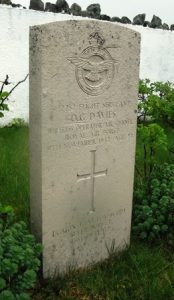
Phillip Thomas Davies, Sergeant, 1152952, Royal Air Force Volunteer Reserve. Phillip was born in 1923, the son of Sydney Arthur Davies and Gwladys Davies (nee Richards), of Llanybri. He enlisted into the Royal Air Force Volunteer Reserve and after completing his training as a Wireless Operator/ Air Gunner was posted to 166 Squadron, Royal Air Force. The Squadron was based at RAF Kirmington, operating first Whitley’s, then Wellington’s and Lancaster Bombers. On the night of 30 August 1943, Philip took off from Kirmington aboard a Vickers Wellington X, Serial LN397, which joined a large bomber force sent to destroy targets in Monchengladbach. The Wellington was lost during the following morning of the raid, presumed to have gone down with the loss of all five of her crew, on the morning of 31 August 1943. Philip, who was just 20 years old, has no known grave and is commemorated on the Runnymede Memorial, Surrey, on Panel 147. There is a memorial to him on his parents grave at Llanybri Churchyard.
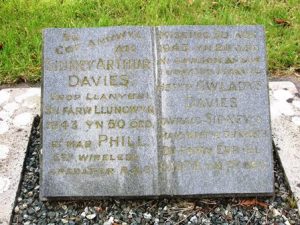
Thomas Anthony Frederick Davies, Sergeant (Navigator), Royal Air Force Volunteer Reserve. Thomas, known as Tony by his family, was the son of James and Mary Ellen Davies, of Carmarthen. He enlisted into the Royal Air Force Volunteer Reserve, and after completing his training as a Navigator, was posted to 158 Squadron, Royal Air Force, which was equipped with the Vickers Wellington II, based at RAF Driffield. On the night of 10 April 1942, Tony took off from Driffield aboard a Vickers Wellington II, Serial W5482, on a Nickel Raid over Lille. These raids took place at the end of a crews training programme, when it was felt that they had reached a certain level of proficiency and were ready for bombing duties and involved the dropping of propaganda leaflets, which were designed to undermine the occupying German forces and to boost the morale of the local inhabitants. Sadly these raids were also very dangerous and many losses were suffered through them. Tony was killed when his Wellington was lost, believed to have crashed into the sea off Oostende, on the following morning of 11 April 1943, with all five of her crew. Thomas was 21 years old when he died that morning. He has no known grave, so is commemorated on the Runnymede Memorial, Surrey. He is also commemorated on his parents grave in St. Mary’s Churchyard, Carmarthen.
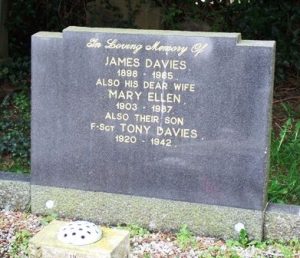
George Francis Done, Sergeant, 1338185, Royal Air Force Volunteer Reserve. George was born in 1921, the son of George Done and Margaret Done (nee Curzon), of 4, Royle Street, Northwich. He had gained his Teachers Diploma at Trinity College, Carmarthen prior to enlisting into the Royal Air Force Volunteer Reserve and after completing his training as a Navigator, was posted to 9 Squadron, Royal Air Force, which was equipped with the Avro Lancaster I, based at RAF Waddington. On 31 January 1943 George was flying as Navigator aboard an Avro Lancaster III, Serial ED481, which was returning home after a successful raid on Hamburg. The Lancaster was diverted to RAF Leeming, but crashed into Hawnby Hill in the North Yorkshire Moors, killing all the crew. George was 21 years old, and was buried in Northwich Cemetery, England. George is not commemorated on the Gremlin Club War Memorial.
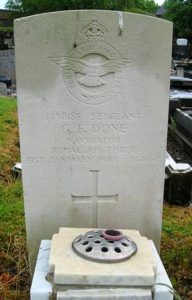
Benjamin Kenneth Hall Evans, Sergeant (Flight Engineer), 1031846, Royal Air Force Volunteer Reserve. Benjamin was born on 19 December 1922. His father must have died when he was young and later became Mrs. Jones, of The Old Bull, Guildhall Square, Carmarthen. He enlisted into the Royal Air Force Volunteer Reserve and after completing his training as a Flight Engineer was posted to 467 (RAAF) Squadron, Royal Air Force, a mainly Australian unit, equipped with the Avro Lancaster I, based at RAF Bottesford. On the night of 12 July 1943, Benjamin took off from Bottesford aboard an Avro Lancaster III, Serial ED531, which joined a large force of bombers despatched to strike targets in Germany. Unfortunately, due to heavy winds, his Lancaster strayed into Swiss airspace and was hit by Swiss anti-aircraft fire. The aircraft jettisoned its bomb load, but became trapped in a valley in a thunderstorm, and flew into high ground at Thyon-les-Collons, killing all seven men aboard. Benjamin was 20 years old when he was killed that night and was buried besides his fellow crewmen in Vevey (St. Martins) Cemetery, Switzerland.
William David Evans, Sergeant, 1005138, Royal Air Force Volunteer Reserve. William was born on 9 October 1915, the son of Robert Evans and Margaret Ann Evans, of 4, Friars Row, Carmarthen. He worked as a Printer’s Compositor prior to enlisting into the Royal Air Force Volunteer Reserve and after completing his training as a Navigator, was posted to 9 Squadron, Royal Air Force, which was a heavy bomber squadron, equipped with the Avro Lancaster I, based at RAF Waddington. On the night of 30 August 1943, William took off from Woodhall Spa aboard an Avro Lancaster III, Serial ED551, which joined a large bomber force despatched to strike targets in Monchengladbach. William was killed when his Lancaster was lost without a trace with all her crew on the following morning of 31 August 1943. The 27-year-old has no known grave, so is commemorated on the Runnymede Memorial, Surrey.
Albert Michael Griffiths, Flight Sergeant, 1382927, Royal Air Force Volunteer Reserve. Albert was born on 6 May 1917, the son of William George Griffiths and Clara Eliza Griffiths, of Shorncliffe, College Road, Carmarthen. He served in London as a Police Officer prior to the war, before enlisting into the Royal Air Force Volunteer Reserve, where he trained as a pilot. Albert was then posted to 72 Squadron, Royal Air Force, which had reformed at RAF Tangmere on 22 February 1937 from ‘B’ flight of 1 Squadron. In 1939, the squadron replaced its outdated Gloster Gladiators with Supermarine Spitfires and carried out air defence and convoy protection duties following the start of the war, before covering the troops withdrawing to Dunkirk. The squadron then took part in the Battle of Britain, and later moved to North Africa to support the Tunisian campaign. The squadron re-equipped with the faster Spitfire IX in 1942, and provided support to the 8th Army as it took part in the invasion of Italy. The squadron moved to Comiso in Sicily after the invasion of the Island in July 1943. Albert was killed during an operational flight on 16 July 1943, when fragments of a Messerschmidt Bf109 which he had shot struck his Spitfire, causing him to crash near Syracuse. The 26-year-old is buried in Syracuse War Cemetery, Sicily.
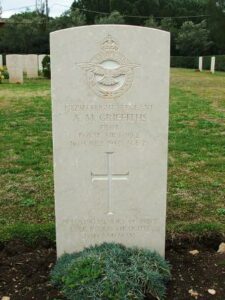
John Howard Griffiths, Sergeant, 1337841, Royal Air Force Volunteer Reserve. John was born in 1922, the son of David Griffiths and Naomi Griffiths (nee Roberts), of 7, Frederick Street, Ferndale. The family was originally from Llanpumsaint and by 1939 had moved back to Brynhyfryd, Bronwydd Arms. John enlisted into the Royal Air Force Volunteer Reserve and after completing his training as a Navigator, was posted to 166 Squadron, Royal Air Force, a medium bomber squadron, equipped with the Vickers Wellington, based at RAF Kirmington. On the night of 23 May 1943, John took off from Kirmington aboard a Vickers Wellington X, Serial HF486, which joined a large force of bombers despatched to strike targets in Dortmund. The Wellington was brought down and crashed into the North Sea off the Dutch Coast during the morning of 24 May 1943, with the loss of all five men aboard. John was 21 years old when he was killed during the crash. His body was later recovered from the sea and he was buried with his fellow crewmen in Amsterdam New Eastern Cemetery, Netherlands alongside his four fallen crew members. His brother David Elwyn Griffiths was killed in North Africa in 1941. (The Gremlin Club memorial shows J. E. Griffiths, but that must be an error).
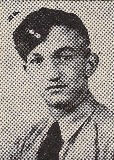
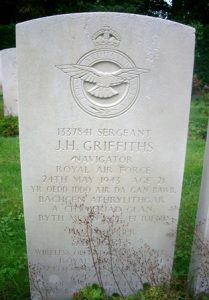
Leslie Evan Thomas Griffiths, 1279953, Aircraftman, Royal Air Force. Leslie was born in 1923, the son of David Griffiths and Mary Margaret Griffiths (nee Evans), of 102, St. Catherine’s Street, Carmarthen. He was baptised at St. Peter’s Church. Very little is currently known of him, but Leslie served with the Royal Air Force for most of the war, before becoming ill, and was discharged as medically unfit. He died of pulmonary tuberculosis at Carmarthen on 25 January 1947, aged 24. He is not commemorated by the CWGC.
David Harold Harries, Sergeant, 1377756, Royal Air Force Volunteer Reserve. David was the son of Thomas and Annie Maria Harries of Penllwynau, Abergwili. He left home to work in a Drapery in Bromley prior to the war and lodged at 23, Palace Road, Bromley. David enlisted into the Royal Air Force Volunteer Reserve and after completing his training as a Wireless Operator/ Air Gunner was posted to 487 (RNZAF) Squadron, Royal Air Force, which was a New Zealand staffed squadron, equipped with the Lockheed Ventura II, based at RAF Feltwell. He married Joyce Lilian Worley, of Southwark, whilst on leave in Blackpool in the summer of 1941. On the night of 6 December 1942, David took off from Feltwell aboard a Lockheed Ventura II, Serial AE902, as part of Operation Oyster, a raid on the Philips radio and valve factory at Eindhoven. Some 93 bombers left Britain to attack the factory, which was extensively damaged, but there were 17 aircraft lost. Among those was the Ventura which David was a crewman in, which was hit by flak at low level and crashed, killing David and three other crewmen. David was 31 years old, and is buried in Eindhoven (Woensel) General Cemetery, Netherlands.
Waldo Harry Bentley Hiles, DSO, DFC, Squadron Leader, 121330, Royal Air Force Volunteer Reserve. Waldo was born in 1913, the son of Thomas Henry Hiles and Rosamund Sarah Hiles (nee Jones), of Myrtle Hill House, Fforestfach, Swansea. His father, a former steel worker, had made his way up the ladder to being a foreman and engineer, making his money in India before buying the Nelson Hotel, at Red Street, Carmarthen. Waldo was educated at St. Paul’s School, Darjeeling, India, and after the family moved to Carmarthen was educated at Llandovery College. Waldo enlisted into the Royal Air Force Volunteer Reserve soon after the outbreak of war and initially served as a Flight Sergeant. He married Elizabeth Anne Shanley in Witney, Oxfordshire in 1940 and the couple had a son, Jenkin Waldo Hiles. Waldo was commissioned from Flight Sergeant on 1 May 1942, then obviously being a brave and competent officer was soon promoted to Squadron Leader as well as receiving several awards for gallantry. On 12 December 1942, Waldo was awarded the DFC as Captain of a heavy bomber in an attack on Stuttgart whilst serving with 218 (Gold Coast) Squadron, Royal Air Force. The citation to his award read; ‘In November, 1942, this officer captained a heavy bomber, detailed to attack Stuttgart. At one point on the outward flight. Flight Lieutenant Hiles brought his aircraft down to 200 feet while his gunners attacked a goods train and put it out of action. He then flew on to his objective and bombed it. During the return journey, attacks were made on targets on the ground, including four separate attacks on goods trains and, in each instance, locomotives were set on fire; Flight Lieutenant Hiles also attacked an enemy aircraft on an airfield. This officer, who has completed a large number of sorties has invariably displayed outstanding skill and daring.’ In June, 1943 Waldo was awarded the DSO for his high qualities of leadership and devotion to duty with 218 Squadron. The citation which was published in the London Gazette of 11 June 1943 stated: ‘Squadron Leader Hiles has been flying on operations since May, 1941, and has completed numerous sorties since being awarded the D.F.C. He always presses home his attacks in the most determined manner, flying at low altitude regardless of enemy opposition.’ He had completed two full tours of operations with 218 Squadron when he was transferred and posted to No. 3 Group HQ at Exning Hall, effectively taking him off active duties, but on the morning of 24 August 1943 Waldo decided to pay a visit to his former Squadron. After sitting in on the briefing for the raid that night on Berlin, Waldo decided to take part himself. He collected a scratch crew made up of inexperienced airmen from the Squadron, and took control of a Short Stirling III, Serial EH925 IC-C of 623 Squadron. Sadly the Stirling was intercepted by a German night fighter and shot down some 25 miles south of Berlin that night, and the entire crew was lost without trace. Waldo was 30 years old when he was killed that night and is commemorated on the Runnymede Memorial, Surrey. His brother, William Jenkin Joseph Hiles, was killed in 1944.
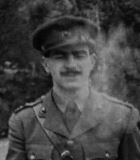
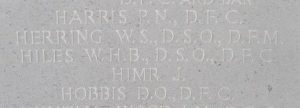
James Hywel Hughes, Sergeant, 1381323, Royal Air Force Volunteer Reserve. James was born on 27 August 1921, the son of William David Hughes and Margaret Hughes (nee Phillips), of Knightsford, near Carmarthen. He worked as a farm worker farm prior to enlisting into the Royal Air Force Volunteer Reserve and after completing his training as a Wireless Operator/Air Gunner was posted to 77 Squadron, Royal Air Force, which was equipped with the Handley Page Halifax II, based at RAF Elvington. On the night of 9 March 1943, James took off from Elvington aboard a Handley Page Halifax II, Serial JB795, which joined a large bomber group despatched to destroy targets in Munich, including the BMW Aero Engine Factory. During the early hours of 10 March 1943, the Halifax was hit by enemy fire and crashed into Lake Constance, killing all her crew of seven. James was just 21 years old when he died that night. His body was later recovered from the lake together with those of his fellow crewmen and buried in Friedrichshafen Cemetery, but in August 1948 the graves of the seven men were exhumed and re-interred in Durnbach War Cemetery, Germany.
Benjamin Bryn Jones, Sergeant, 1183725, Royal Air Force Volunteer Reserve. Benjamin was born on 21 June 1920, the son of Henry Jones and Margaret Jones, of 93a, Priory Street, Carmarthen. He worked as a fruiterer for his father prior to enlisting into the Royal Air Force Volunteer Reserve and after completing his training as an Air Gunner was posted to 207 Squadron, Royal Air Force, which was equipped with the Avro Lancaster I, based at RAF Langar. On the night of 26 April 1943, Benjamin took off from Langar aboard an Avro Lancaster I, Serial W4171, which joined a large bomber group despatched to strike targets in Duisberg. During the early hours of the following morning, 27 April 1943, the Lancaster was intercepted by a German night fighter and shot down at Mol, some six miles Northeast of Geel, killing all seven of her crew. Benjamin was 22 years old when he was killed that night, and was buried together with his fellow crewmen in Schoonselhof Cemetery, Belgium.
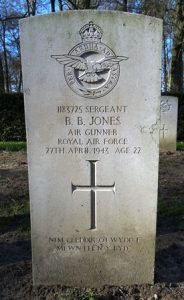
Brynmor Samuel Jones, Sergeant, 1061957, Royal Air Force Volunteer Reserve. Brynmor was born on 5 January 1916, the son of George and Eliza Jones, of 43, St. Catherine Street, Carmarthen. He worked as a clerk for the Carmarthenshire Insurance Company prior to enlisting into the Royal Air Force Volunteer Reserve, and after completing his training as an Air Gunner was posted to 57 Squadron, Royal Air Force, which was equipped with the Vickers Wellington II, based at RAF Feltwell. On the night of 15 October 1941, Brynmor took off from Feltwell aboard a Vickers Wellington IC, Serial X9978, which joined a large bomber group despatched to strike targets in Cologne. During the early hours of the following morning, 15 October 1941, the Wellington was intercepted by a German night fighter, and was shot down, crashing with the loss of all six of her crew at Grevenbicht, some five Miles Northwest of Sittard. Brynmor was 25 years old when he was killed that night and was buried alongside his fellow crewmen in Venlo British Cemetery. In August 1947 the cemetery was cleared and the war graves were re-interred in Jonkerbos War Cemetery, Netherlands.
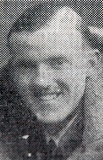
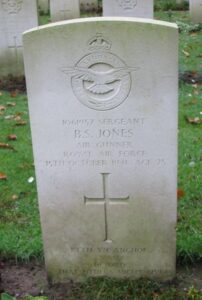
David John Jones, DFM, Pilot Officer, 129218, Royal Air Force Volunteer Reserve. David was born in 1920, the son of James Jones and Ellen Gwen Jones (nee Harries), of Bryn Llawddgar, Pontyates. His mother was from Llandyfaelog. After being educated at Carmarthen Grammar School, David enlisted into the Royal Air Force Volunteer Reserve, training as a Wireless Operator/ Air Gunner, before being posted to 12 Squadron, Royal Air Force, which was equipped with the Vickers Wellington III. On the evening of 28 August 1942, David took off from RAF Binbrook, aboard Vickers Wellington Z8656, which was part of a large formation sent to bomb strategic targets around Cassel, France. He was killed when his Wellington was shot down over Germany that night, 28 August 1942, with the loss of all her crew of five, three of whom were Welshmen. The 22-year-old is buried in Reichswald Forest War Cemetery, Germany. David was the holder of the Distinguished Flying Medal. He was a cousin to Daniel Evan Jenkins, who was also killed.
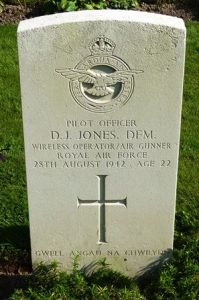
Derrick Isaac Jones, Flying Officer (Navigator/Bomber), 120809, Royal Air Force Volunteer Reserve. Derrick was born in 1920, the son of David John Jones and Margaret Ann Jones (nee Owen), of 7, Water Street, Carmarthen. After leaving Carmarthen Grammar School he enlisted into the Royal Air Force Volunteer Reserve and after training as a Navigator/ Bomber was posted to No. 1 (Coastal) Operational Training Unit, for specialist training prior to joining a front-line squadron. At just after midnight on the morning of 10 November 1942, Derrick took off from RAF Silloth, on the Solway Firth, as Navigator of a Lockheed Hudson, Serial AM680, flown by Flight Sergeant John Frederick Saunders, on a night navigation exercise. About half an hour later the aircraft sent out a radio message, stating: ‘I will call you again later’, but nothing more was heard. The Hudson had crashed at Beda Fell near Ullswater in thick fog on 10 November 1942, bursting into flames on impact, and killing all five men aboard. The local police and the RAF sent out search parties to try and find the aircraft, and it was not until the following day that the wreckage was located. Derrick was 22 years old when he was killed during the crash. His remains were recovered from the wreckage and he was brought home for burial in Carmarthen Cemetery.
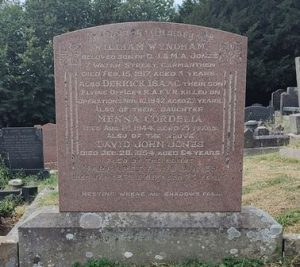
Herbert Llewelyn Jones, Sergeant (Flight Engineer), 570542, Royal Air Force. Herbert was born on 2 January 1921, the son of David John Jones and Esther Elizabeth Jones (nee Walters), of 51, High Street, Abergwili. His mother Elizabeth died in 1923, and Herbert went to live with his grandparents, John and Harriet Jones and at Brynderwen, Llanarthney. After leaving his local school at Llanarthney, Herbert gained a place in Carmarthen Grammar School. He enlisted into the Royal Air Force upon leaving school and after completing his training as a Flight Engineer was posted to 9 Squadron, Royal Air Force, which was a medium bomber Squadron, originally equipped with the Vickers Wellington. The squadron utilised their Wellington’s on anti-shipping sorties in the early stages of the war, before converting to Avro Lancaster’s in September 1942 and joined RAF Bomber Command, based at RAF Waddington. On the night of 4 April 1943 Herbert took off from Waddington aboard Avro Lancaster, Serial ED696 which was part of a force bound for Kiel. The Lancaster was intercepted by a German night-fighter on the following morning, 5 April 1943, and crashed in flames near Grossenaspe, killing all seven of her crew. Herbert, who was just 22 years old, was buried alongside his fellow crewmen in Neumunster Civil Cemetery, but their graves were later exhumed and they were re-interred in Hamburg Cemetery, Germany in September 1946. His uncle, Herbert James Jones, fell during The Great War.
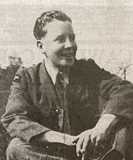
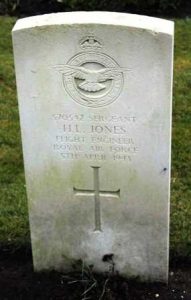
Mervyn Anthony Jones, Flight Sergeant, 748630, Royal Air Force Volunteer Reserve. Mervyn was born at Llwynwhilwg Farm, Llanelli on 12 May 1919, the son of Herbert Jones and Anne Elisabeth Jones (nee Anthony). The family later owned Cillefwr Farm, Carmarthen and Mervyn was educated at Queen Elizabeth’s Grammar School, Carmarthen. Mervyn was a well-known jockey prior to the war and had won the Grand National Steeplechase in 1940, riding Bogskar, not long after having enlisted into the Royal Air Force along with his brother William. Both men qualified as Pilots, and Mervyn was posted to No. 1 Photographic Reconnaissance Unit, Royal Air Force, which was equipped with the Supermarine Spitfire. Mervyn was posted missing after a North Sea sortie on 3 April 1942, when his Spitfire, Serial AA797, was intercepted and shot down into the Fjord between Frosta and Tømmerdalen in Leksvik. Mervyn parachuted, but drowned before a German rescue launch could save him. The 22-year-old has no known grave, and is commemorated on the Runnymede Memorial, Surrey. His brother William was killed just over two years later. Both brothers medals were sold at Dix Noonan Webb on 6 July 2004. A fellow Spitfire from the same unit, Spitfire, AA810, has recently been discovered and recovered from the same Fjord and is in the process of being restored.
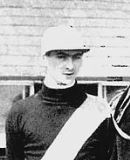
Richard Glynne Jones, Aircraftman 2nd Class, 1171578, Royal Air Force Volunteer Reserve. Richard was born on 7 August 1915, the son of Richard Garrick Jones and Lucy Jones (nee Angelinetta), of 6 Chaxton Street, Oxford. His father was from Carmarthen and had worked as a compositor with the Weekly Reporter in Carmarthen until serving in the Great War, and his Aunt was Mrs Parson, of 11 Friars Park, Carmarthen. Richard worked as an electrician prior to enlisting into the Royal Air Force and was posted to RAF Honington, as Ground Crew. During the afternoon of 19 August 1940, the Germans launched two intruder attacks on RAF Honington. The first attack took place at 16.15, killing four servicemen and injuring many others, whilst HE bombs were later dropped and fell around the parade square. Richard was among the four killed that day. The 25-year-old was buried in All Saints Churchyard, Honington, Suffolk. Richard is not commemorated on the Gremlin Club War Memorial.
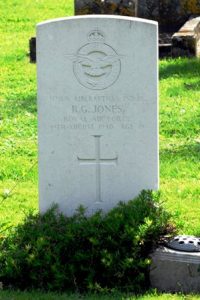
William Hywel Anthony Jones, DFC, Flying Officer, 139316, Royal Air Force Volunteer Reserve. William was born at Llwynwhilwg Farm, Llanelli on 25 December 1915, the son of Herbert Jones and Anne Elisabeth Jones (nee Anthony). The family later owned Cillefwr Farm, Carmarthen and William and his brother Mervyn were educated at Carmarthen Grammar School. William was a well known jockey like his brother Mervyn, and rode against him in the 1940 Grand National, falling from his horse ‘National Night’. William had enlisted into the Royal Air Force Volunteer Reserve with Mervyn, and qualified as a Pilot, joining 517 Squadron, Royal Air Force, which was a Coastal Command unit, equipped with the Handley Page Halifax V, based at RAF Brawdy. During the war, William made several daring attacks against German U-Boats. He was awarded the Distinguished Flying Cross, and was also Mentioned in Despatches for his gallantry during the war. The recommendation for his DFC, published in the London Gazette of 20 August 1943, read; ‘Pilot Officer Jones has maintained a very high standard in his work throughout his operational career. He made four attacks on U-Boats, inflicting damage on three occasions. He has also made a very determined attack on a blockade runner. Recently he was captain of an aircraft which successfully fought off attacks by seven Ju. 88s over a period of 45 minutes. The safe return of the aircraft was largely due to this officer’s fine tactics and superb airmanship.’ His Mention in despatches was listed in the London Gazette of 1 January 1943. William was posted missing during his second tour of operations on 14 November 1944 when his Wellington was forced to ditch off Lundy Island, in the Bristol Channel, when unable to land due to bad weather conditions, after returning from a Meteorological Recce Sortie. The 29-year-old has no known grave and is commemorated on the Runnymede Memorial, Surrey. His medals were sold along with Mervyn’s in a Dix Noonan Webb Auction on 6 July 2004.
William Llewellyn Wynn Jones, Flying Officer, 135670, Royal Air Force Volunteer Reserve. William was born on 5 February 1909, the son of John Henry Jones and Martha Lilian Jones, of The Globe Inn, Blaina. He studied at Trinity College, Carmarthen prior to becoming a schoolteacher, and upon his return to Blaina married Florence Eileen Chaffey. The couple then moved to 90, Rectory Road, Thurrock, where William had gained a position as Deputy Schoolmaster. William enlisted into the Royal Air Force Volunteer Reserve soon after the outbreak of war and after qualifying as a Navigator was posted to 514 Squadron, Royal Air Force, which flew the Avro Lancaster II, based at RAF Waterbeach. On 1 May 1944, William took off from Waterbeach aboard an Avro Lancaster II, Serial LL732, which joined a large bomber group despatched to hit railway installations in Chambly, the main railway depot and stores for the northern French railway network. The raid was extremely successful, but during the return leg on the following morning, 2 May 1944, William’s Lancaster was intercepted and shot down by a German night-fighter, crashing near Chaumont-en-Vexin, France, with the loss of all seven crewmen. William was 35 years old when he was killed that day and was buried besides his fellow crewmen in St. Sever Cemetery Extension, Rouen, France. His widow, Florence, went to live with her parents at Bourneville, Birmingham after William’s death. She never remarried and died in 2004. Despite residing in Carmarthen for several years, William is not commemorated on the Gremlin Club War Memorial.
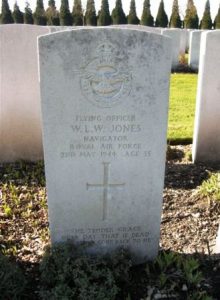
Alan John McLaren Keay, Aircraftman 2nd Class, 305234, Royal Air Force Volunteer Reserve. Alan was born on 22 January 1926, the son of Cyril Francis McLaren Keay and Dorothy Margaret Keay (nee McLeod), of Leicester. He was educated at Carmarthen Grammar School prior to enlisting into the Royal Air Force Volunteer Reserve and was posted to No 16 Elementary Flight Training School at Burnaston, Derbyshire to train as a pilot. On 9 March 1945 Alan was flying a Tiger Moth II, Serial DE473, in poor visibility when it collided with a Handley Page Halifax of 1665 Heavy Conversion Unit near Abbotts Bromley, killing Alan and his instructor and also the entire crew of the Halifax. Alan was 19 years old and is buried in Repton (St. Wystan) Churchyard, Derbyshire. Alan is shown on the memorial as Keary.
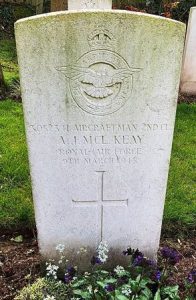
John Daniel Kingdon, Sergeant, 1013673, Royal Air Force Volunteer Reserve. John was born on 7 September 1911, the son of Daniel Richard Kingdon and Alice Kingdon (nee Burnell), of 95, Llandaff Road, Cardiff. He married Dora Howard Parfitt at Cardiff in the Spring of 1939 and the couple came to live at 17, Millbrook Crescent, Carmarthen, after he had gained work in the town as an Insurance Inspector. John enlisted into the Royal Air Force Volunteer Reserve soon after the outbreak of war and after training as a Pilot was posted to 9 Squadron, Royal Air Force, which flew the Vickers Wellington IC, initially based at RAF Lossiemouth. On the night of 23 June 1942, John took off from RAF Honington, flying a Vickers Wellington III, Serial X3423, which joined thirteen other aircraft on a raid on the dockyards at St. Nazaire. The raid was a failure, due to the target being missed by eleven of the aircraft, so the raiders headed back to England. John’s Wellington crashed into the ground near Wantage during the early hours of 24 June 1942, killing John and three of his crew. The remains of the 30-year-old were recovered from the wreckage and he was cremated at Pontypridd Crematorium. His widow, Dora, later remarried and continued to live in Carmarthen. Despite living in Carmarthen before the war, John is not commemorated on the Gremlin Club War Memorial.
Desmond Lewis, Sergeant, 1414771, Royal Air Force Volunteer Reserve. Desmond was born in 1925, the son of William Titus Lewis and Margaret Lewis (nee Evans), of 55, Abergwili Road, Carmarthen. After leaving Carmarthen Grammar School he enlisted into the Royal Air Force Volunteer Reserve and after completing his training as an Air Bomber, he was posted to 429 (Royal Canadian Air Force) Squadron, Royal Air Force, which flew the Vickers Wellington Mark X based at RAF East Moor. On the night of 26 January 1943, Desmond took off from East Moor aboard a Vickkers Wellington III, Serial BK163, which joined a force of 156 other bombers sent to bomb the U-Boat pens at Lorient, in France. Desmond was killed, together with his entire crew, when their Wellington was lost without trace on the following morning, 27 January 1943. Desmond was just 17 years old when he was killed that night. He has no known grave, so is commemorated on the Runnymede Memorial, Surrey. He was in fact one of the youngest men to be killed serving with Bomber Command during the war.
John Irfon Lewis, Leading Aircraftman, 649703, Royal Air Force Volunteer Reserve. John was born in 1921, the son of Robert Lewis and Mary Ceinwen Lewis (nee Price), of Rose Cottage, Carmarthen. He enlisted into the Royal Air Force Volunteer Reserve and after completing his training was posted to Egypt to join 14 Squadron, Royal Air Force, which was equipped with the Martin B-26 Marauder I, based at RAF Fayid. John initially served as Groundcrew, but then became a Flight Engineer. On 1 March 1943 he took off from RAF Faid aboard a Martin B-26 Marauder, Serial FK117, on a training flight, piloted by Pilot Officer Fletcher. The men began to practicing single-engine circuits at Fayid, but whilst approaching the airfield to land, after their circuits, the aircraft stalled and the pilot lost control, crashing short of runway, killing John and himself. John was 21 years old when he was killed that day, and he was buried in Fayid War Cemetery, Egypt.
David Henry Brynmor Norman, Sergeant, 1422929, Royal Air Force Volunteer Reserve. David was born in 1923, the son of Charles Thomas Norman and May Norman (nee Williams), of 4, Merlin Street, Carmarthen. He enlisted into the Royal Air Force Volunteer Reserve and trained as an Air Gunner before being posted to 178 Squadron, Royal Air Force. The Squadron was equipped with Liberators at Shandur, Egypt on 15 January 1943 and then moved to Libya. In March 1944 the Squadron, equipped with the B-24 Liberator VI, became based at RAF Amendola, in Italy and was involved in the air drop operations in support of the besieged Polish Home Army in Warsaw in 1944.On 8 January 1945 David took off from Amendola aboard a Consolidated B-24 Liberator VI, Serial KG928, on a Special Operation supply drop to partisans near Ljubljana, in Yugoslavia. The Liberator crashed in Serbia in poor weather conditions, killing all eight men aboard, including David. The 21-year-old was buried besides his comrades in Belgrade War Cemetery, Serbia & Montenegro. His brother William Christopher Norman was killed in 1944.
Thomas Brian Owen, Sergeant, 1162333, Royal Air Force Volunteer Reserve. Thomas was born in Laugharne on 31 October 1920, the son of William Owen and Annie Owen (nee Thomas). The family later resided in Ystrad, Carmarthen. Thomas was a Sergeant in the Royal Air Force Volunteer Reserve during the war, and remained in the services after the surrender of Germany and Japan in 1945, being posted to No. 5 School of Technical Training at RAF St. Athan. Thomas contracted tuberculosis during his time there and died at the RAF Hospital at St. Athan on 30 May 1947. The remains of the 26-year-old were brought home and he was buried in the new graveyard at St. Martin’s church, Laugharne.
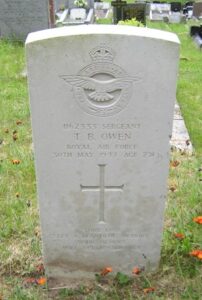
David Gareth Rees, Sergeant, 1653285, Royal Air Force Volunteer Reserve. David was born in 1924, the son of Tudor Rees and Elizabeth Rees (nee Davies), of 1, Babell Road, Pensarn, Carmarthen. He enlisted into the Royal Air Force Volunteer Reserve and after completing his training as a Flight Engineer was posted to 166 Squadron, Royal Air Force, a Bomber Command Squadron which flew the Avro Lancaster, based at RAF Kirmington. On the night of 22 October 1943, David took off from Kirmington aboard an Avro Lancaster III, Serial ED366, which joined a large bomber group despatched to strike targets in Kassel, Germany. David was killed, together with five fellow crewmen, when their Lancaster was shot down and crashed at Obermeiser, southeast of Warburg, that night. David was 22 years old when he was killed that night and was buried together with his fellow crewmen in a communal grave in Westuffeln Civil Cemetery. In June 1947 the men’s graves were exhumed and they were re-interred in Hanover War Cemetery, Germany. David is not commemorated on the Gremlin Club War Memorial.
Gilbert Humphreys Rogers, Sergeant, 1382746, Royal Air Force Volunteer Reserve. Gilbert was born on 3 May 1915, the son of Herbert Rogers and Margaret Rogers (nee Humphreys), of 3, Plasbach, Reservoir Road, Carmarthen. He was a Postman at Carmarthen prior to enlisting into the Royal Air Force Volunteer Reserve and after completing is training as an Air Gunner was posted to 75 (New Zealand) Squadron, Royal Air Force. The squadron was a heavy bomber unit, crewed mainly by New Zealanders, and was equipped with the Short Stirling, based at RAF Newmarket Heath. Gilbert was killed when his Stirling, Serial EF340, Identifier AA-Q, was lost mine whilst on mine laying duties in the Nectarine region off the Friesian Islands on 5 May 1943. The 27-year-old has no known grave, so is commemorated on the Runnymede Memorial, Surrey. An elder brother, Thomas Humphrey Rogers, was killed in France in 1918, during the Great War.
Russell Veirian Rosser, DFM, Sergeant (Pilot), 1313694, Royal Air Force Volunteer Reserve. Russell was born on 30 May 1921, the son of David Rosser and Margaret Anne Rosser (nee Thomas), of Greenhill, Pontyates. After being educated at Carmarthen Grammar School, he found work as a Carpenter’s Mate, but left his job to enlist into the Royal Air Force Volunteer Reserve, and after qualifying as a pilot, was posted to 196 Squadron, Royal Air Force, which flew the Vickers Wellington X, based at RAF Leconfield. Russell was then attached to 466 (Royal Australian Air Force) Squadron at Leconfield. On 19 February his aircraft, Wellington HE-531, became the first aircraft in the squadron to shoot down a German night fighter which had damaged their Wellington. On 14 April 1943, Russell took off from Leconfield flying a Vickers Wellington X, Serial HE166 and took part in a raid on Stuttgart. The Wellington safely got back to England, landing at Tangmere on the following morning and Russell and his crew managed to snatch some sleep before taking off from Tangmere on the following day, 15 April 1943, to return to Leconfield. Tragically an engine cut out as the Wellington was starting to climb and the stricken aircraft plunged three miles west of the airfield, killing Russell and his crew of four. The remains of the 21-year-old were recovered from the wreckage, and he was brought home for burial in St. Mary’s Churchyard, Pontyates. He was the holder of the Distinguished Flying Medal.
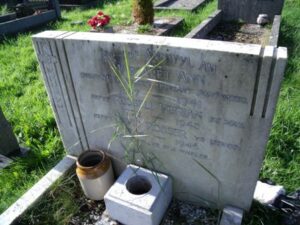
T. Stephens, Flight Sergeant. Cannot presently be identified.
Daniel Goronwy Thomas, Flight Sergeant (Air Gunner), 1499060, Royal Air Force Volunteer Reserve. Daniel known as Ron, was born in 1921, the son of Elias Thomas and Rachel Thomas (nee Davies), of Greenhill, Llansadwrn. He enlisted into the Royal Air Force Volunteer Reserve and after completing his training as an Air Gunner was posted to 617 Squadron, Royal Air Force. The Squadron was made famous during its most daring raid on 16/17 May 1943, when it took part in Operation Chastise, the famous Dambusters Raid. Ron did not take part in the Dambusters Raid, but joined the squadron afterwards, as a replacement for the heavy casualties suffered. Daniel had taken part in a raid by the Squadron on the Tirpitz on 15 September 1944, Operation Paravane, when Lancasters from 617 Squadron and 9 Squadron badly damaged the great warship at her berth in Tromso Fjord, Norway. The Lancasters had used the airfield at Yagodnik, Russia as a base for the daring raid. On 17 September 1944 Ron took off from Yagodnik aboard Avro Lancaster PB416, to return to base via RAF Lossiemouth. Tragically the Lancaster crashed into high ground near Nesbyen, Norway after being blown off course by strong winds, killing all ten men aboard. Ron was 23 years old when he perished in the crash, and was originally buried together with his fellow crewmen near to the crash site in the mountains. The graves of all the men were exhumed and re-interred into Nesbyen Churchyard, Norway after the war.
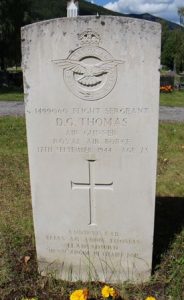
David John Dudley Thomas, Sergeant, Royal Air Force Volunteer Reserve. David was born on 13 April 1922, the son of Mansel Thomas and Elizabeth Thomas (nee Phillips), of Porthyrhyd, Tanerdy, Carmarthen. He worked as a painter with his father prior to enlisting into the Royal Air Force Volunteer Reserve and after completing his training as a Wireless Operator/ Air Gunner, was posted to 226 Squadron, Royal Air Force, a medium bomber squadron which flew the Douglas Boston IIIA, based at Swanton Morley. On 25 January 1943 David took off from Swanton Morley aboard a Douglas Boston III, Serial W8354, which joined a number of other aircraft despatched to strike targets in Flushing Docks, in Vlissingen. David and his three fellow crewmen were killed when their Boston was hit by Naval flak and crashed near Vlissingen Airfield. The 20-year-old was buried besides his fellow crewmen in Flushing (Vlissingen) Northern Cemetery, Netherlands. David is not commemorated on the Gremlin Club War Memorial, although there is a man named D. L. Thomas (below), who cannot be identified, so this is possibly an error on the memorial?
D. L. Thomas, Sergeant. Cannot presently be identified, but is possibly David John Dudley Thomas (above)?
Melville Elvet Thomas, Aircraftman 1st Class, 1312270, Royal Air Force Volunteer Reserve. Melville was born on 30 September 1920, the son of David Thomas and Annie Thomas (nee Jones), of Towy Cottage, Llangunnor. He worked as a coach body builder prior to enlisting into the Royal Air Force Volunteer Reserve and was posted to RAF Technical Command at RAF Tangmere. Melville was asleep in his barracks at Shepperton during the early hours of 23 February 1944 when a German High Explosive bomb was dropped and brought the building down on him. His body was recovered from the ruins, and the remains of the 23-year-old were conveyed home and buried in St. Cynwyr’s Churchyard, Llangunnor on 28 February. Melville is not commemorated on the Gremlin Club War Memorial.
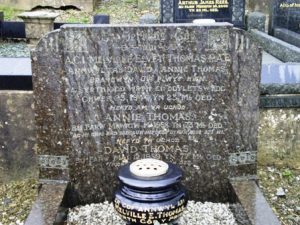
Percy Thomas, Sergeant, 967631, Royal Air Force Volunteer Reserve. Percy was born in 1921, the son of Rees Thomas and Lizzie Thomas (formerly Evans), of Gwarcwm, Llanpumsaint. He enlisted into the Royal Air Force Volunteer Reserve and after completing his training as a Wireless Operator/ Air Gunner was posted to 61 Squadron, Royal Air Force, which was based at Wick, and equipped with the Handley Page Hampden. On the night of 1 March 1941, Percy was one of the crew members aboard a Handley Page Hampden, Serial X3147, which took off from RAF Hemswell, Lincolnshire as part of a force of over 130 aircraft bound for Cologne. The raid was a success, but when the aircraft returned to England, the ground was found to be covered in a thick fog. Percy’s Hampden ran out of fuel while desperately searching for a place to land, and crashed at Syderstone, Norfolk early in the morning of 2 March 1941. The doomed Hampden burst into flames, killing all of the crew. Percy was 21 years old when he died in the crash. His remains were recovered from the wreckage and he was brought home for burial in Bethel Calvinistic Methodist Chapelyard, Llanpumsaint.
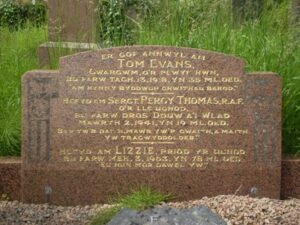
Stephen George Thomas, Flight Sergeant, 1314103, Royal Air Force Volunteer Reserve. Stephen was born on 27 September 1922, the son of Stephen Lewis Thomas and Helen Josephine Thomas (nee Murphy), of 1, Friars Row, Carmarthen. He enlisted into the Royal Air Force Volunteer Reserve and after completing his training was posted to 14 Squadron, Royal Air Force, which was equipped with the Martin B-26 Marauder, medium bomber. After the Allied invasion of Italy, 14 Squadron moved to Ghisonaccia, on the island of Corsica to carry out strategic bombing missions over mainland Italy. On 15 December 1943 Stephen took off from Ghisonaccia aboard a Martin Marauder I, Serial FK127, on a low flying navigational exercise. The aircraft went missing, believed to have crashed into the sea off the Algerian coast, with the loss of all six of her crew. Stephen was 21 years old, and is commemorated on the Malta Memorial, Malta.
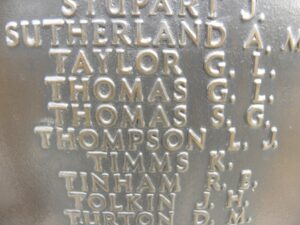
Lawrence Walters, Warrant Officer, 1316296, Royal Air Force Volunteer Reserve. Lawrence was born in 1922, the son of Rachel Eunice Walters, the daughter of William John Walters, of Ffordd, Llangain. His mother married Percy Allney Jones, of Carmarthen, in 1926 and later emigrated with him to Australia. Lawrence enlisted into the Royal Air Force Volunteer Reserve and after gaining his pilots wings was posted to the Far East to join 681 Squadron, Royal Air Force, which had been formed at Dum Dum in India in 1943, flying on coastal defensive work. The Squadron was initially equipped with the Spitfire IV, but was re-equipped with the Mosquito IX in August that year. In October it received a batch of brand new Supermarine Spitfire XI’s, and moved to Alipore in May 1944. The Squadron flew missions over the Far East throughout its time at war. Lawrence was tragically drowned during a swimming incident on 22 February 1945. The 23-year-old has no known grave, so is commemorated on the Singapore Memorial, Kranji.
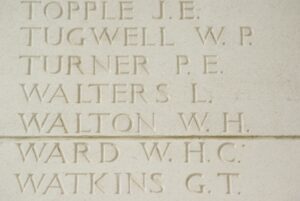
David Eric Williams, Aircraftman 2nd Class, 1047445, Royal Air Force Volunteer Reserve. David was born on 1 December 1920, the son of David Williams and Ellen Williams (nee Jones), of 16, St. Clears Road, Johnstown, Carmarthen. He worked as a Solicitor’s Clerk prior to enlisting into the Royal Air Force Volunteer Reserve and was posted to No. 1 Recruits Centre at RAF St. Athan. David became seriously ill on 16 June 1941 and was admitted to the RAF hospital at St. Athan, where he died that same day of meningitis. The body of the 20-year-old was conveyed home and he was buried in St. Luke’s Churchyard, at Llanllwch.
